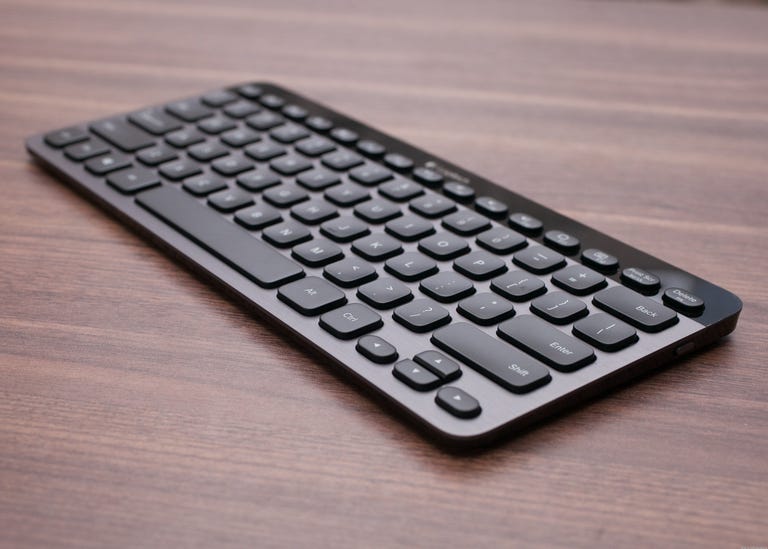 Why You Can Trust CNET
Why You Can Trust CNET
Logitech Bluetooth Illuminated Keyboard K810 review: Typing luxury for multidevice households You'll pay much for the Logitech K810 keyboard, but it's also the most versatile product in its class.
It's hard to envision a single broad usage model for Logitech's new Bluetooth Illuminated Keyboard K810. Here's how Logitech describes it: "A stylish, backlit keyboard with one-touch easy switching between your PC, tablet, and smartphone."
The Good
The Bad
The Bottom Line
I don't suspect many people wish they had a keyboard handy to swap between those three particular devices, but Logitech is nonetheless onto something with the K810.
I can imagine using this keyboard primarily with a tablet. I can see swapping it between a tablet and a desktop, or perhaps among multiple tablets. It would even make a great living-room keyboard thanks to its tidy, unobtrusive design.
Regardless of its intended use, anyone who buys the K810 will pay a lot for the privilege, given the $99.99 price tag. Those who make that commitment will at least get to enjoy a well-made, attractive piece of hardware. They might even take advantage of its device-swapping capabilities.
Logitech seems to have almost directly targeted
The K810's keys feel a touch springier than Apple's. Apple's keyboard also uses two AA batteries, while Logitech's relies on charging via an included Micro-USB cable. Logitech says a single charge will last 10 days, which you can extend if you use the on/off switch.
Logitech's keyboard also has a dedicated Windows 8 key, in the same place where you'll find the Option key on Apple's keyboard. Regardless of any OS-specific features, though, both keyboards will work with any contemporary device equipped with a Bluetooth receiver. I successfully connected it to computers running OS X, Windows 8, and Windows 7, as well as multiple iOS devices, an Android-powered smartphone, and a PlayStation 3.
The fact that the K810 is backlit is significant. Apple's keyboard is not, and neither is Microsoft's new
The motion sensor automatically toggles the lighting power when you move your hand to the keyboard. Another sensor measures the ambient light level, and adjusts the backlight brightness accordingly. You can also adjust the light output up or down manually via a set of function keys. When you stop typing for a few seconds, the backlight shuts down.
The K810's other key feature is its Bluetooth functionality. Apple's and Microsoft's keyboards pair with one device at a time. This keyboard (like
The generic benefit of that multipairing is that you can easily move the K810 between paired devices. You can use it with a desktop and then bring it with you when you switch to a tablet. You can use it with a PlayStation 3 or a living-room PC. Multiple-tablet households or workplaces might also appreciate the K810.
The process of pairing the K810 with another device is simple. Hold down one of the three Bluetooth hot keys on the function row to put the keyboard in pairing mode, then put the device you want to pair it with in discovery mode. Once the keyboard shows up on the list of available devices, select it and you'll receive a key code to type. Enter the numbers, hit Enter, and you've made a match.
If you want to replace a device you've already paired with the K810, simply hold down the appropriate hot key to put it back into pairing mode.
This process worked seamlessly on every device I tried. That doesn't mean this keyboard necessarily makes sense to use with every device.
You'll want to make sure you have a stand to hold your tablet or smartphone upright, for one thing. Unlike Microsoft's Wedge keyboard, the K810 does not include one.
Those devices also present the dilemma wherein the keyboard works well for typing within an application, but you can't navigate around without reaching over to touch the screen. That might be belaboring the obvious, but in the familiar zone of typing on a keyboard, you might feel frustrated by the fact that you don't also have immediate cursor control.
A "home button" function key on the K810 can at least bring you back to the home screen on any tablet device. And in Android, when you start typing on the K810, it automatically brings up the search screen. That's useful, but in general a dedicated tablet or smartphone keyboard is meant for long-form typing, making it a pretty situational accessory for those devices.
Those issues are not unique to the K810. And of course you wouldn't want to use it with a tablet or smartphone all the time. The fact that you can have it paired with multiple devices, though, makes it easy to snatch the keyboard away from a desktop that you might use it with more regularly.
Conclusion
For many people, the K810's $99 price tag will mark it as more of a luxury than a casual purchase. The backlight and the design will have instant appeal, but the multidevice Bluetooth pairing won't click with everyone at first. Those who do realize the potential of the multipairing function, and who have a need for it, will likely find the K810 uncommonly useful. If you can live without backlighting, you can get multipairing for less with Logitech's $80
solar-powered K760
. Apple's and Microsoft's Bluetooth keyboards are cheaper still, and although they will pair with only one Bluetooth device at a time, they're no less effective in providing the basics of wireless typing.


